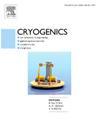Design and development of an apparatus for evaluating multi-layer insulation effectiveness
IF 2.1
3区 工程技术
Q3 PHYSICS, APPLIED
引用次数: 0
Abstract
The development of the cryogen-free ultra-high field superconducting (CRUISE) motor presents a significant advancement in electric propulsion technology. This is especially true for high power density applications such as aircraft propulsion. The CRUISE motor aims to achieve a rated power of 10 MW with a specific energy density of 40 kW/kg and an efficiency of 99.4 %, outperforming existing motor technologies. A key component of the CRUISE motor is the cryogenic low-loss rotor, cooled by a rotor-mounted cryocooler which can maintain the superconducting coils at 50 K. Given the limited cooling power capacity of cryocoolers, the total rotor loss must remain below 10 W, necessitating the use of a highly efficient radiation shield. In this study, a carefully designed and accurate experimental setup that directly measures small heat inputs was developed to characterize the thermal performance of multi-layer insulation (MLI) thermal shields under controlled cryogenic conditions of 50 K and above. Interleaved MLI samples with different layer numbers were tested and evaluated. By reducing parasitic heat losses, this apparatus enabled highly accurate assessment of MLI performance, underscoring the importance of layer density, compression, and fabrication quality in minimizing thermal conductance. The findings reveal that while uncompressed MLI systems meet the stringent thermal management requirements of the CRUISE motor, operational compression significantly impacts their thermal conductance. The study further validates the developed models and identifies opportunities for optimizing MLI layer alignment, spacer design, and resilience to compression, paving the way for more efficient thermal management in a variety of applications.
多层绝缘效能评估装置的设计与研制
无低温超高场超导(CRUISE)电机的发展是电力推进技术的重大进步。对于飞机推进等高功率密度应用尤其如此。CRUISE电机的额定功率为10 MW,比能量密度为40 kW/kg,效率为99.4 %,优于现有的电机技术。CRUISE电机的一个关键部件是低温低损耗转子,由安装在转子上的制冷机冷却,该制冷机可以将超导线圈保持在50 K.鉴于制冷机的冷却能力有限,转子的总损耗必须保持在10 W以下,因此需要使用高效的辐射屏蔽。在这项研究中,设计了一个精心设计和精确的实验装置,直接测量小的热输入,以表征多层隔热(MLI)热屏蔽在50 K及以上的受控低温条件下的热性能。对不同层数的交错MLI样品进行了测试和评价。通过减少寄生热损失,该仪器能够高度准确地评估MLI性能,强调层密度、压缩和制造质量在最小化热导方面的重要性。研究结果表明,虽然未压缩的MLI系统满足CRUISE发动机严格的热管理要求,但操作压缩会显著影响其导热性。该研究进一步验证了开发的模型,并确定了优化MLI层对齐、隔离器设计和压缩弹性的机会,为在各种应用中更有效的热管理铺平了道路。
本文章由计算机程序翻译,如有差异,请以英文原文为准。
求助全文
约1分钟内获得全文
求助全文
来源期刊

Cryogenics
物理-热力学
CiteScore
3.80
自引率
9.50%
发文量
0
审稿时长
2.1 months
期刊介绍:
Cryogenics is the world''s leading journal focusing on all aspects of cryoengineering and cryogenics. Papers published in Cryogenics cover a wide variety of subjects in low temperature engineering and research. Among the areas covered are:
- Applications of superconductivity: magnets, electronics, devices
- Superconductors and their properties
- Properties of materials: metals, alloys, composites, polymers, insulations
- New applications of cryogenic technology to processes, devices, machinery
- Refrigeration and liquefaction technology
- Thermodynamics
- Fluid properties and fluid mechanics
- Heat transfer
- Thermometry and measurement science
- Cryogenics in medicine
- Cryoelectronics
 求助内容:
求助内容: 应助结果提醒方式:
应助结果提醒方式:


